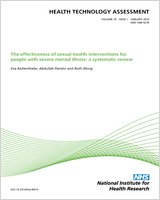NCBI Bookshelf. A service of the National Library of Medicine, National Institutes of Health.
Headline
There is uncertainty about which treatments for extravasation injuries are most promising, but saline flush-out techniques and conservative management approaches may be suitable for evaluation in trials.
Abstract
Background:
Extravasation injuries are caused by unintended leakages of fluids or medicines from intravenous lines, but there is no consensus on the best treatment approaches.
Objectives:
To identify which treatments may be best for treating extravasation injuries in infants and young children.
Design:
Scoping review and survey of practice.
Population:
Children aged < 18 years with extravasation injuries and NHS staff who treat children with extravasation injuries.
Interventions:
Any treatment for extravasation injury.
Main outcome measures:
Wound healing time, infection, pain, scarring, functional impairment, requirement for surgery.
Data sources:
Twelve database searches were carried out in February 2017 without date restrictions, including MEDLINE, CINAHL (Cumulative Index to Nursing and Allied Health Literature) Plus and EMBASE (Excerpta Medica dataBASE).
Methods:
Scoping review – studies were screened in duplicate. Data were extracted by one researcher and checked by another. Studies were grouped by design, and then by intervention, with details summarised narratively and in tables. The survey questionnaire was distributed to NHS staff at neonatal units, paediatric intensive care units and principal oncology/haematology units. Summary results were presented narratively and in tables and figures.
Results:
The evidence identified in the scoping review mostly comprised small, retrospective, uncontrolled group studies or case reports. The studies covered a wide range of interventions including conservative management approaches, saline flush-out techniques (with or without prior hyaluronidase), hyaluronidase (without flush-out), artificial skin treatments, debridement and plastic surgery. Few studies graded injury severity and the results sections and outcomes reported in most studies were limited. There was heterogeneity across study populations in age, types of infusate, injury severity, location of injury and the time gaps between injury identification and subsequent treatment. Some of the better evidence related to studies of flush-out techniques. The NHS survey yielded 63 responses from hospital units across the UK. Results indicated that, although most units had a written protocol or guideline for treating extravasation injuries, only one-third of documents included a staging system for grading injury severity. In neonatal units, parenteral nutrition caused most extravasation injuries. In principal oncology/haematology units, most injuries were due to vesicant chemotherapies. The most frequently used interventions were elevation of the affected area and analgesics. Warm or cold compresses were rarely used. Saline flush-out treatments, either with or without hyaluronidase, were regularly used in about half of all neonatal units. Most responders thought a randomised controlled trial might be a viable future research design, though opinions varied greatly by setting.
Limitations:
Paucity of good-quality studies.
Conclusions:
There is uncertainty about which treatments are most promising, particularly with respect to treating earlier-stage injuries. Saline flush-out techniques and conservative management approaches are commonly used and may be suitable for evaluation in trials.
Future work:
Conventional randomised trials may be difficult to perform, although a randomised registry trial may be an appropriate alternative.
Funding:
The National Institute for Health Research Health Technology Assessment programme.
Contents
- Plain English summary
- Scientific summary
- Chapter 1. Background
- Chapter 2. Scoping review of treatments for extravasation injuries
- Chapter 3. Survey of NHS practice
- Chapter 4. Discussion
- Chapter 5. Conclusions
- Acknowledgements
- References
- Appendix 1. Database search strategies
- Appendix 2. Studies excluded as being about other extravasations
- Appendix 3. Case report study details
- Appendix 4. Survey questionnaire content
- Appendix 5. Further questionnaire results
- List of abbreviations
About the Series
Article history
The research reported in this issue of the journal was funded by the HTA programme as project number 15/175/02. The contractual start date was in February 2017. The draft report began editorial review in October 2017 and was accepted for publication in March 2018. The authors have been wholly responsible for all data collection, analysis and interpretation, and for writing up their work. The HTA editors and publisher have tried to ensure the accuracy of the authors’ report and would like to thank the reviewers for their constructive comments on the draft document. However, they do not accept liability for damages or losses arising from material published in this report.
Declared competing interests of authors
William McGuire is a member of the Health Technology Assessment Commissioning Board and the Health Technology Assessment and Efficacy and Mechanism Evaluation Editorial Boards.
Disclaimer
The views expressed in this report are those of the authors and not necessarily those of the NIHR Health Technology Assessment programme. Any errors are the responsibility of the authors.
Last reviewed: October 2017; Accepted: March 2018.
- NLM CatalogRelated NLM Catalog Entries
- Treatment of extravasation injuries in infants and young children: a scoping rev...Treatment of extravasation injuries in infants and young children: a scoping review and survey
- A pragmatic randomised controlled trial of the effectiveness and cost-effectiven...A pragmatic randomised controlled trial of the effectiveness and cost-effectiveness of ‘PhysioDirect’ telephone assessment and advice services for physiotherapy
- Acta1 actin alpha 1, skeletal muscle [Mus musculus]Acta1 actin alpha 1, skeletal muscle [Mus musculus]Gene ID:11459Gene
Your browsing activity is empty.
Activity recording is turned off.
See more...
